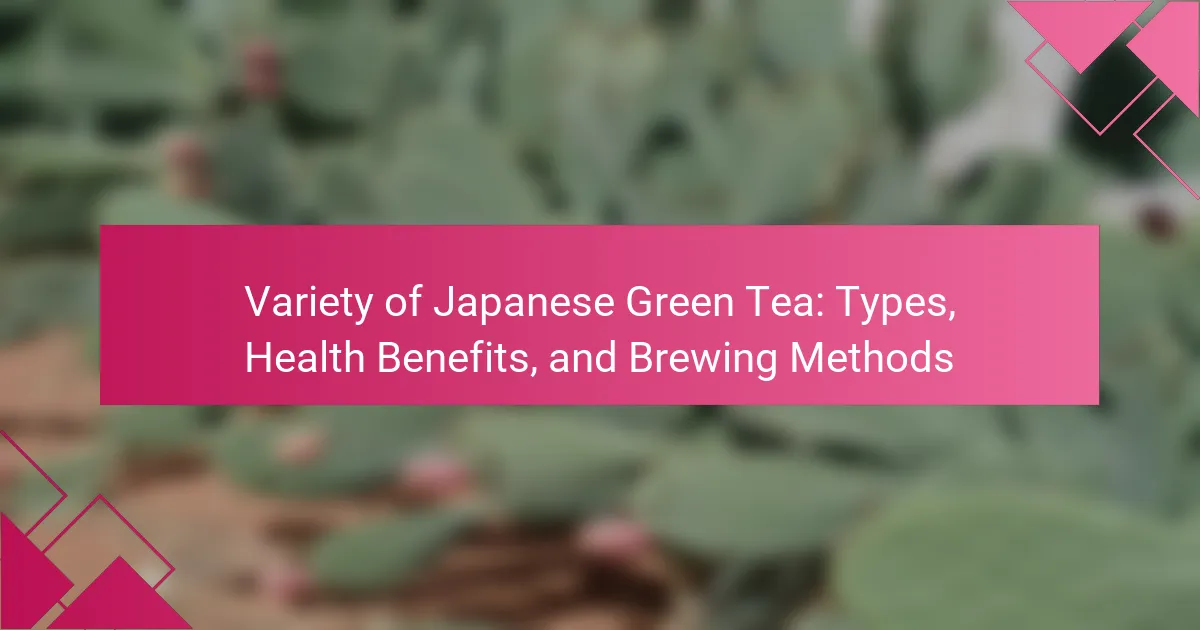
What is Japanese Green Tea?
Japanese green tea is a type of tea made from Camellia sinensis leaves. It is known for its vibrant green color and rich flavor. The leaves are steamed or pan-fired shortly after harvesting. This process preserves the green color and nutritional properties. Japanese green tea is rich in antioxidants, particularly catechins. It is often consumed for its potential health benefits, such as improved metabolism and heart health. Popular varieties include Sencha, Matcha, and Gyokuro. Each type has unique flavor profiles and preparation methods.
How is Japanese Green Tea different from other types of tea?
Japanese green tea is distinct from other types of tea due to its unique cultivation and processing methods. It is primarily steamed during production, which preserves its vibrant green color and fresh flavor. Other green teas, such as Chinese varieties, are often pan-fired, leading to different taste profiles. The shading technique used for certain Japanese teas, like matcha, enhances their umami flavor and increases chlorophyll content. Additionally, Japanese green tea typically contains higher levels of catechins, a type of antioxidant. This results in various health benefits, including improved metabolism and heart health. The meticulous growing conditions in Japan, such as specific soil types and climate, also contribute to its unique characteristics.
What are the unique characteristics of Japanese Green Tea?
Japanese Green Tea is known for its distinct characteristics. It often features a vibrant green color, which indicates high chlorophyll content. The flavor profile is typically grassy and vegetal, attributed to the unique processing methods. Japanese Green Tea is primarily steamed during production, preserving its fresh taste. This steaming process also contributes to its higher levels of catechins, beneficial antioxidants.
Another unique characteristic is the presence of umami, a savory taste that enhances the overall flavor experience. Varieties like Matcha and Gyokuro showcase this umami more prominently due to specific cultivation techniques. The tea leaves are often shade-grown, which increases the amino acid content.
Japanese Green Tea is also recognized for its delicate aroma, which can range from sweet to nutty. Its brewing temperature is lower compared to other green teas, typically around 160°F to 180°F, to avoid bitterness. These characteristics make Japanese Green Tea distinct in both flavor and health benefits.
Why is the cultivation process important for Japanese Green Tea?
The cultivation process is crucial for Japanese Green Tea because it directly influences the flavor, aroma, and quality of the tea. Specific cultivation techniques, such as shading, enhance the production of chlorophyll and amino acids. This results in a sweeter and more umami-rich flavor profile. Additionally, the timing of harvest plays a significant role. Early spring harvests yield tender leaves with higher antioxidant levels. Soil quality and climate conditions also affect the growth and characteristics of the tea plants. For instance, volcanic soil in regions like Uji contributes to unique taste profiles. Proper cultivation methods ensure consistency and high standards in tea production. This is essential for maintaining the cultural significance and reputation of Japanese Green Tea globally.
What are the main types of Japanese Green Tea?
The main types of Japanese green tea are Sencha, Matcha, Gyokuro, Hojicha, and Genmaicha. Sencha is the most popular type, known for its refreshing flavor and vibrant green color. Matcha is a powdered tea used in traditional tea ceremonies, offering a rich, umami taste. Gyokuro is shade-grown, resulting in a sweet and delicate flavor profile. Hojicha is roasted green tea, which gives it a unique toasty aroma and brown color. Genmaicha combines green tea with roasted brown rice, providing a nutty flavor. Each type has distinct characteristics and brewing methods that contribute to its unique taste and aroma.
What distinguishes Sencha from other varieties?
Sencha is distinguished from other varieties of Japanese green tea by its unique processing method and flavor profile. Unlike other types, Sencha leaves are steamed shortly after harvest, which preserves their green color and fresh taste. This steaming process enhances the umami flavor, making it more pronounced compared to other varieties like Gyokuro or Matcha. Additionally, Sencha typically has a lighter, more vegetal taste with a slight astringency. Its vibrant green color and aromatic qualities further set it apart. The cultivation of Sencha often involves exposure to sunlight, contributing to its distinct flavor and higher catechin content. These characteristics make Sencha a popular choice among green tea enthusiasts.
How does Matcha differ in preparation and consumption?
Matcha differs in preparation and consumption compared to other teas. Matcha involves grinding whole tea leaves into a fine powder. This powder is then whisked with hot water, creating a frothy beverage. In contrast, traditional teas are usually steeped in water, extracting flavors without consuming the leaves.
The preparation of matcha requires specific utensils, such as a bamboo whisk and bowl. This method enhances the tea’s flavor and texture. Additionally, matcha consumption is unique as it includes the entire leaf, providing higher antioxidant levels.
Research indicates that matcha contains up to 137 times more antioxidants than regular green tea. This is due to its unique preparation method, which retains the nutrients found in the whole leaf.
What are the characteristics of Gyokuro and its cultivation?
Gyokuro is a premium Japanese green tea known for its unique flavor and cultivation method. Its leaves are shaded for about three weeks before harvest, which enhances its sweet taste and reduces bitterness. Gyokuro typically has a rich umami flavor profile, with a vibrant green color and a delicate aroma. The cultivation involves careful attention to soil quality and climate, primarily grown in regions like Uji and Yame. The shading process increases chlorophyll content, resulting in a higher concentration of amino acids. Gyokuro leaves are hand-picked, ensuring only the finest leaves are selected. This meticulous process contributes to its status as one of the highest grades of Japanese green tea.
What health benefits does Japanese Green Tea offer?
Japanese Green Tea offers numerous health benefits. It is rich in antioxidants, particularly catechins. These compounds help reduce oxidative stress in the body. Studies show that Japanese Green Tea can improve brain function. It may enhance fat burning and boost metabolic rate. Research indicates it can lower the risk of heart disease. Regular consumption is linked to improved dental health. Additionally, it may help regulate blood sugar levels.
How does Japanese Green Tea contribute to overall health?
Japanese Green Tea contributes to overall health through its rich content of antioxidants, particularly catechins. These antioxidants help reduce oxidative stress in the body. Studies show that regular consumption of Japanese Green Tea can lower the risk of heart disease. For example, a study published in the Journal of the American College of Nutrition found that green tea drinkers had a 26% lower risk of heart disease. Additionally, Japanese Green Tea can aid in weight management by boosting metabolism. Research in the American Journal of Clinical Nutrition indicated that catechins can increase fat oxidation during exercise. Furthermore, the L-theanine in green tea promotes relaxation and reduces stress. This combination of benefits supports overall health and well-being.
What specific antioxidants are found in Japanese Green Tea?
Japanese green tea contains specific antioxidants known as catechins. The primary catechin in Japanese green tea is epigallocatechin gallate (EGCG). This compound is renowned for its health benefits, including anti-inflammatory and anti-cancer properties. Other catechins present include epicatechin, epicatechin gallate, and epigallocatechin. Research has shown that these antioxidants contribute to cardiovascular health and weight management. A study published in the “Journal of Nutritional Biochemistry” highlights the role of EGCG in reducing oxidative stress. These antioxidants are a key reason for the popularity of Japanese green tea in health circles.

How can one brew Japanese Green Tea effectively?
To brew Japanese green tea effectively, use water at the correct temperature and steep for the right duration. Typically, water should be heated to 70-80°C (158-176°F) for most Japanese green teas. This temperature preserves the delicate flavors and prevents bitterness. Use about 1 teaspoon of tea leaves per 150 ml of water. Steep the tea for 1-3 minutes, depending on the type. Sencha usually requires about 1-2 minutes, while Gyokuro benefits from a longer steep of 2-3 minutes. Using high-quality tea leaves enhances the flavor and health benefits. Proper brewing techniques maximize the tea’s antioxidants and umami taste.
What are the essential steps in brewing Japanese Green Tea?
The essential steps in brewing Japanese green tea include selecting the right tea leaves, measuring the correct amount, heating water to the right temperature, steeping the tea for the appropriate time, and serving. First, choose high-quality Japanese green tea leaves like Sencha or Matcha. Use about one teaspoon of loose leaves per cup. Heat water to around 70-80°C (158-176°F) for most green teas. Pour the heated water over the tea leaves in a teapot or cup. Steep the tea for 1-3 minutes, depending on the type. Finally, pour the brewed tea into cups, ensuring to strain out the leaves if necessary.
What is the ideal water temperature for brewing different types?
The ideal water temperature for brewing different types of Japanese green tea varies. Generally, the temperature ranges from 60°C to 80°C (140°F to 176°F). For delicate teas like Gyokuro, a lower temperature of 60°C to 65°C (140°F to 149°F) is recommended. Sencha is best brewed at 70°C to 80°C (158°F to 176°F). Matcha requires water at about 80°C (176°F). Hojicha can be brewed with boiling water at 90°C to 100°C (194°F to 212°F). These temperature guidelines enhance flavor extraction and preserve the tea’s health benefits.
How long should each type of Japanese Green Tea be steeped?
Sencha should be steeped for 1 to 2 minutes. Gyokuro requires a shorter steeping time of 1 to 1.5 minutes. Matcha does not need steeping; it is whisked directly in water. Hojicha can be steeped for 30 seconds to 1 minute. Genmaicha typically steeps for 2 to 3 minutes. The steeping time varies based on the tea type and desired flavor. Proper steeping enhances the taste and health benefits of each tea.
What tools are recommended for brewing Japanese Green Tea?
Recommended tools for brewing Japanese Green Tea include a Kyusu, a fine mesh strainer, and a thermometer. A Kyusu is a traditional Japanese teapot designed for steeping green tea. It typically has a built-in strainer, facilitating easy pouring. A fine mesh strainer is useful for preventing tea leaves from entering the cup. A thermometer ensures the water temperature is ideal, usually around 70-80°C for most green teas. Additionally, a tea scale can help measure the correct amount of tea leaves, typically 1-2 grams per ounce of water. These tools enhance the brewing process and ensure optimal flavor extraction.
Why is a kyusu preferred for brewing Japanese Green Tea?
A kyusu is preferred for brewing Japanese green tea due to its design and material. The kyusu typically features a fine mesh strainer, which allows for optimal infusion of tea leaves. This design ensures that the delicate flavors of the tea are extracted without bitterness. Additionally, kyusus are often made from clay or ceramic, which can enhance the tea’s taste. The shape of the kyusu promotes even heat distribution, allowing for precise temperature control. Japanese green tea requires specific brewing temperatures, usually between 140°F to 185°F. Using a kyusu helps in maintaining these ideal temperatures. Overall, the kyusu’s attributes significantly contribute to a superior tea-drinking experience.
What role does a tea whisk play in preparing Matcha?
A tea whisk is essential for preparing Matcha. It aerates the tea and creates a frothy texture. The whisk helps dissolve the powdered tea in water, ensuring an even mixture. This tool is traditionally made from bamboo, known as a chasen. Using a whisk allows for optimal flavor release from the Matcha. The process requires a specific technique, typically a back-and-forth motion. Proper whisking enhances the overall drinking experience. A well-prepared Matcha showcases its vibrant color and rich taste.

What are some common mistakes when brewing Japanese Green Tea?
Common mistakes when brewing Japanese Green Tea include using water that is too hot. Ideal brewing temperature for most types is between 160°F to 180°F. Using boiling water can scorch the leaves. Another mistake is steeping for too long. Most green teas require only 1 to 3 minutes of steeping time. Over-steeping can lead to bitterness. Additionally, using too many tea leaves is a frequent error. A typical ratio is about 1 teaspoon per 6 ounces of water. Lastly, not pre-warming the teapot can affect the temperature stability during brewing. Pre-warming helps maintain the optimal brewing temperature. These mistakes can significantly impact the flavor and quality of the tea.
How can improper brewing affect the taste of Japanese Green Tea?
Improper brewing can significantly alter the taste of Japanese Green Tea. Factors such as water temperature, steeping time, and tea leaf quantity are crucial. Using water that is too hot can lead to bitterness. Japanese Green Tea typically requires lower temperatures, around 160°F to 185°F. Oversteeping can also result in astringency and unpleasant flavors. Ideally, steeping should last between 1 to 3 minutes, depending on the type of tea. Additionally, using too many tea leaves can overpower the delicate flavors. A standard measure is about 1 teaspoon per 6 ounces of water. These brewing variables directly influence the overall flavor profile, aroma, and enjoyment of the tea.
What are the signs of oversteeping or using incorrect water temperature?
The signs of oversteeping or using incorrect water temperature include bitterness, astringency, and a dull flavor profile. Oversteeping leads to excessive tannin extraction, resulting in a harsh taste. Incorrect water temperature can also cause similar issues. For example, using boiling water on delicate green teas can scorch the leaves. This results in a loss of the tea’s natural sweetness and aroma. Additionally, a cloudy appearance in the brewed tea may indicate improper brewing conditions. These factors collectively affect the overall enjoyment and quality of the tea.
What tips can enhance the experience of drinking Japanese Green Tea?
To enhance the experience of drinking Japanese Green Tea, focus on proper brewing techniques and quality tea selection. Use fresh, high-quality loose leaf tea for optimal flavor. Water temperature is crucial; use water between 160°F to 180°F for delicate varieties like Gyokuro. Steep for the recommended time, typically 1-3 minutes, depending on the type. Use a teapot or kyusu designed for green tea to allow for proper infusion. Enjoy the tea in a quiet environment to appreciate its aroma and taste fully. Pairing with traditional Japanese snacks can complement the tea’s flavors. These practices are supported by tea enthusiasts and experts who emphasize the importance of water quality and temperature in tea brewing.
How can one pair Japanese Green Tea with food for a better experience?
Pairing Japanese Green Tea with food enhances flavor and enjoyment. Match the tea’s profile with complementary dishes. For example, match Sencha with light seafood or salads. The umami in Sencha complements the freshness of these foods. Pair Matcha with sweets like mochi or cakes. The richness of Matcha balances well with sweet flavors. Gyokuro, with its sweet and grassy notes, pairs nicely with delicate dishes like sushi. The tea’s smoothness enhances the overall dining experience. Additionally, consider temperature; serve cooler teas with lighter foods. This contrast can elevate the tasting notes.
What are some best practices for storing Japanese Green Tea?
Store Japanese green tea in an airtight container to preserve its freshness. This prevents exposure to air, which can degrade flavor and aroma. Keep the container in a cool, dark place away from direct sunlight. Light can also diminish the quality of the tea. Maintain a stable temperature, ideally between 15°C to 20°C (59°F to 68°F). Avoid storing tea in the refrigerator, as humidity can negatively affect its taste. Use opaque containers to shield the tea from light. Lastly, keep the tea away from strong odors, as it can absorb them easily. Following these practices ensures the tea retains its unique flavors and health benefits.
Japanese green tea, derived from Camellia sinensis leaves, is recognized for its vibrant green color, rich flavor, and numerous health benefits, including improved metabolism and heart health. This article explores various types of Japanese green tea, such as Sencha, Matcha, and Gyokuro, highlighting their unique characteristics, cultivation methods, and preparation techniques. Additionally, it discusses the specific antioxidants found in Japanese green tea, the ideal brewing methods, and common mistakes to avoid. The article aims to provide a comprehensive understanding of Japanese green tea, including its health benefits and best practices for brewing and pairing with food.
